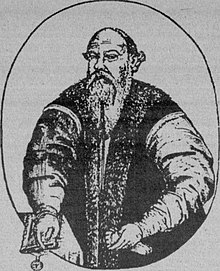Albertas Goštautas
Albertas Goštautas | |
|---|---|
| Grand Chancellor of Lithuania | |
 | |
| Coat of arms | Abdank |
| Born | c. 1480 Vilnius, Grand Duchy of Lithuania |
| Died | December 1539 Vilnius, Grand Duchy of Lithuania |
| Noble family | Goštautai |
| Spouse(s) | Sofija Verejskaja |
| Issue | Stanislovas Goštautas |
| Father | Martynas Goštautas |
| Mother | NN Galshansky |
Albertas Goštautas (Latin: Albertus Gastold, Polish: Olbracht (Wojciech) Gasztołd, Belarusian/Ukrainian: Альберт Гаштольд) (c. 1480 – 1539) was a Lithuanian noble of the Goštautai family from ethnic Lithuanian lands of the Grand Duchy of Lithuania. Voivode of Navahrudak since 1508, Voivode of Polotsk since 1514, Voivode of Trakai since 1519 and Voivode of Vilnius since 1522. In 1522 he became Grand Chancellor of Lithuania. He was the initiator and the editor of the First Statute of Lithuania, as a successor of his staunch opponent Mikolaj Radziwiłł,[1] who rivaled him in the precedence in the Council of Lords. His subsequent rival in influence in the Grand Duchy was Konstanty Ostrogski. In 1529, he received the title of count from Pope Clement VII, and in the following year, thanks to the efforts of Jan Dantyszek, he received the title of Graf of Murowane Gieranojny from Emperor Charles V.[2]
Albertas was a son of Martynas Goštautas and an unknown daughter of Semyon Semyonovich Galshansky (also called Trabski).[3] Albertas' father married later Anna Galshansky, daughter of her first wive's uncle Yury Semyonovich Galshansky.[3] Albertas was orphaned at the age of several years and was brought up by his stepmother and maternal grandmother, Maryna Trabska, daughter of Prince Dmitri Semyonovich Drucki in 1490 bequeathed to him her entire estate.[4]
It is likely that Goštautas studied around 1492 at the Jagiellonian University in Kraków. In 1501, he travelled to the imperial court in Vienna.[5]

It is believed Goštautas, as well as the rest of Goštautai family members, had retained their native Lithuanian language.[6] He knew the Polish language perfectly.[5] Influenced by the ideas of the Protestant Reformation, Goštautas was a supporter of the Lithuanian culture and language in state affairs and had a nationalistic attitude: he segregated non-Lithuanian and Polish-speaking Franciscans, took care of the representatives of Lithuanian literature, such as Abraomas Kulvietis, and showed distrust to Ruthenian inhabitants of the Grand Duchy.[7][8]
He is one of the characters on the famous painting by Jan Matejko, Prussian Homage.
Family[edit]
Albertas Goštautas married before 1506 Sofia Vereiskaya, daughter of Russian voivode Vasily Mikhailovich Vereisky and Maria Palaiologina.[9] Vasily Vereisky was coming from the Rurikovich family, as the great-grandson of Dmitry Donskoy, Grand Prince of Moscow, grandson of Andrei, Prince of Mozhaysk, and son of Mikhail, Prince of Vereya.[10]
Vasily got into a dispute with Grand Prince Ivan III over the dowry of his wife Maria, daughter of Andreas Palaiologos titular Byzantine Emperor, and niece of Sophia Palaiologina, wife of the Grand Prince. The dispute ended with the loss of the hereditary principality and Vasily's escape with his wife to Lithuania, where, on 2 October 1484, he received the estates of Lubcha, Koidanova, Radashkovichy and Valozhyn from King Casimir IV Jagiellon.[9]
These estates were inherited by Sophia and she managed them together with her husband, and after his death she held them until her death on August 1549. After her death, the estate passed to King Sigismund II Augustus.[9] The marriage was a significant elevation for Albertas, whose family was not one of the knyaz families. In 1522, King Sigismund I the Old gave Sofia, her husband and offspring the right to seal letters with red wax, which only royal blood persons were entitled to.[9]
Albertas' son was Stanislovas Goštautas, the last male heir of the Goštautai family. He was buried in Vilnius Cathedral, where his tomb remains until the present day. He built the Hieraniony Castle (whose ruins renmain in present-day Belarus).[citation needed]
References[edit]
- ^ (in Lithuanian) http://ausis.gf.vu.lt/mg/nr/2002/09/09stat.html Archived 27 September 2006 at the Wayback Machine Edition Stages of the Lithuanian Statutes
- ^ Pociecha 1958, p. 301.
- ^ a b Wolff 1895, p. 98.
- ^ Wolff 1895, pp. 57–58.
- ^ a b Pociecha 1958, p. 300.
- ^ (in Lithuanian) Tomas Sakalauskas "The Oak of Mažvydas"
- ^ Dubonis, Artūras. "Lietuvių kalba: poreikis ir vartojimo mastai (XV a. antra pusė – XVI a. pirma pusė)". viduramziu.istorija.net. Retrieved 29 October 2019.
- ^ "Albertas Goštautas". vle.lt. Retrieved 29 October 2019.
- ^ a b c d Wolff 1895, p. 549.
- ^ Wolff 1895, p. 263.
Bibliography[edit]
- Pociecha, Wojciech (1958). "Olbracht Gasztołd". Polski Słownik Biograficzny (in Polish). Vol. 7. Wrocław. pp. 299–303.
{{cite encyclopedia}}: CS1 maint: location missing publisher (link) - Wolff, Józef (1895). Kniaziowie litewsko-ruscy od końca czternastego wieku [Lithuanian-Ruthenian knyazes from the end of the fourteenth century] (in Polish). Warsaw.
{{cite book}}: CS1 maint: location missing publisher (link)
